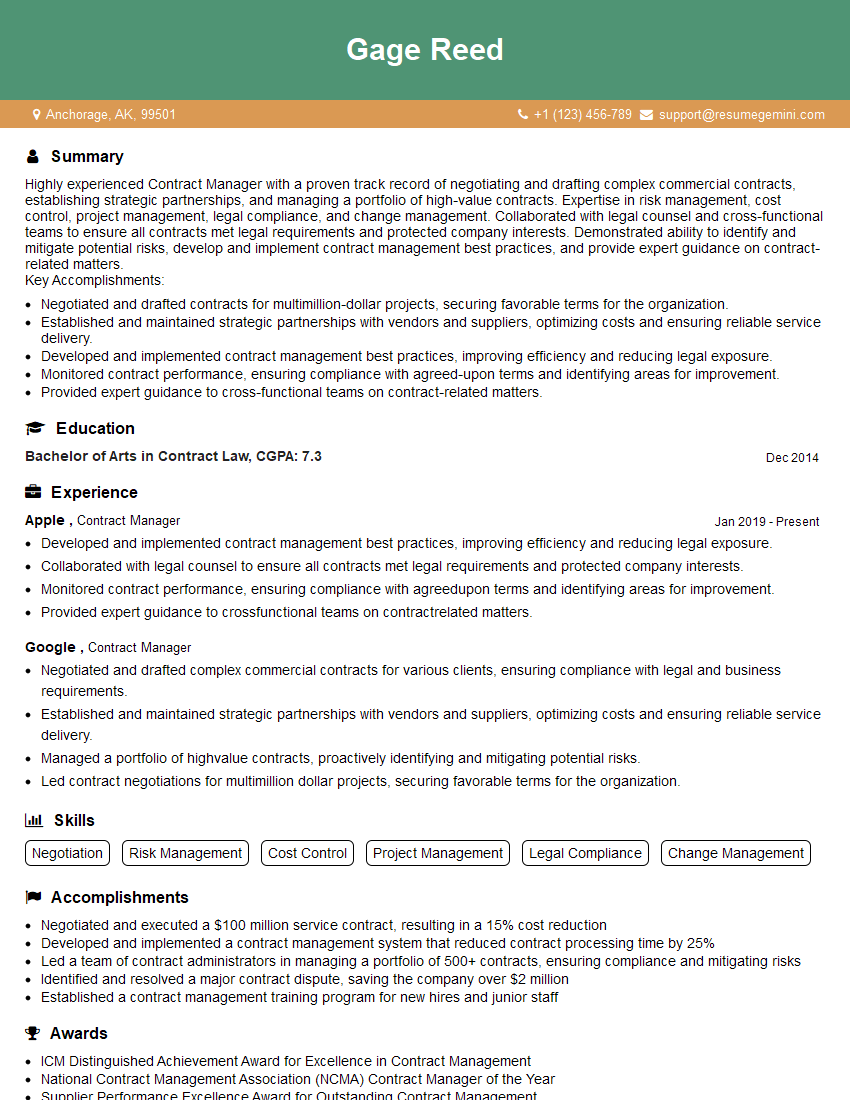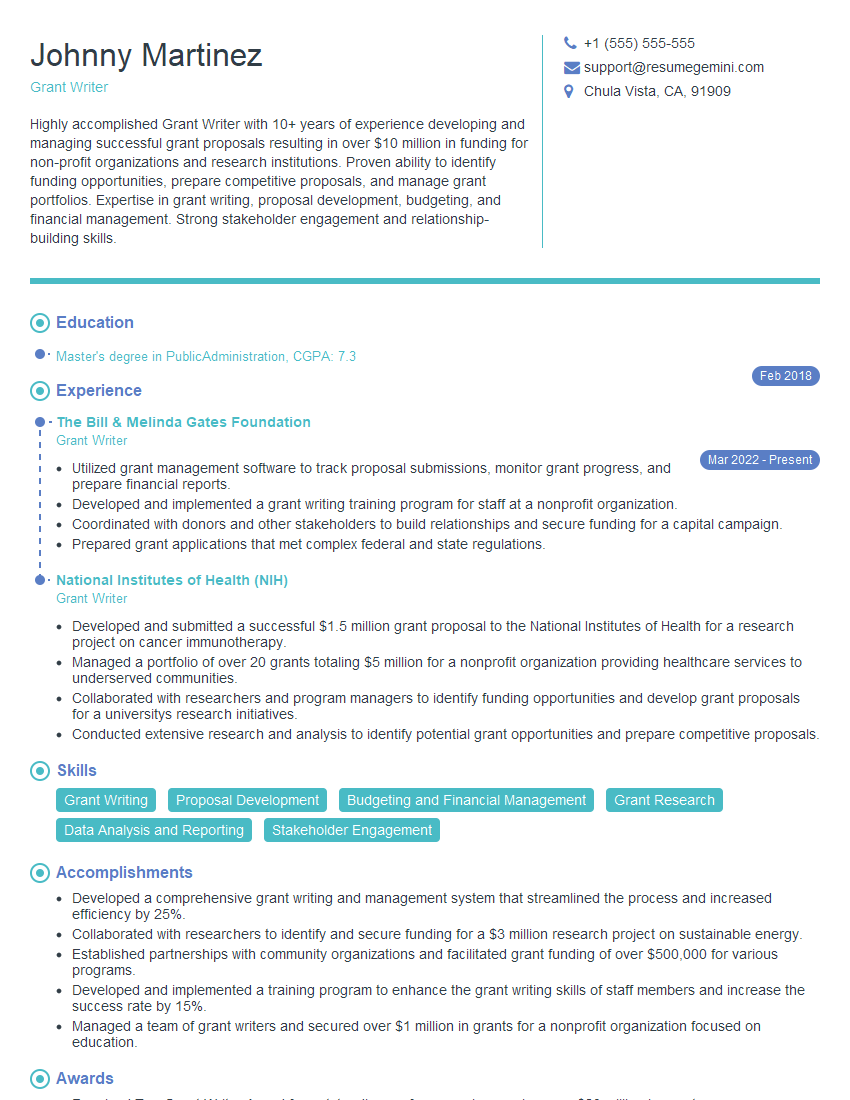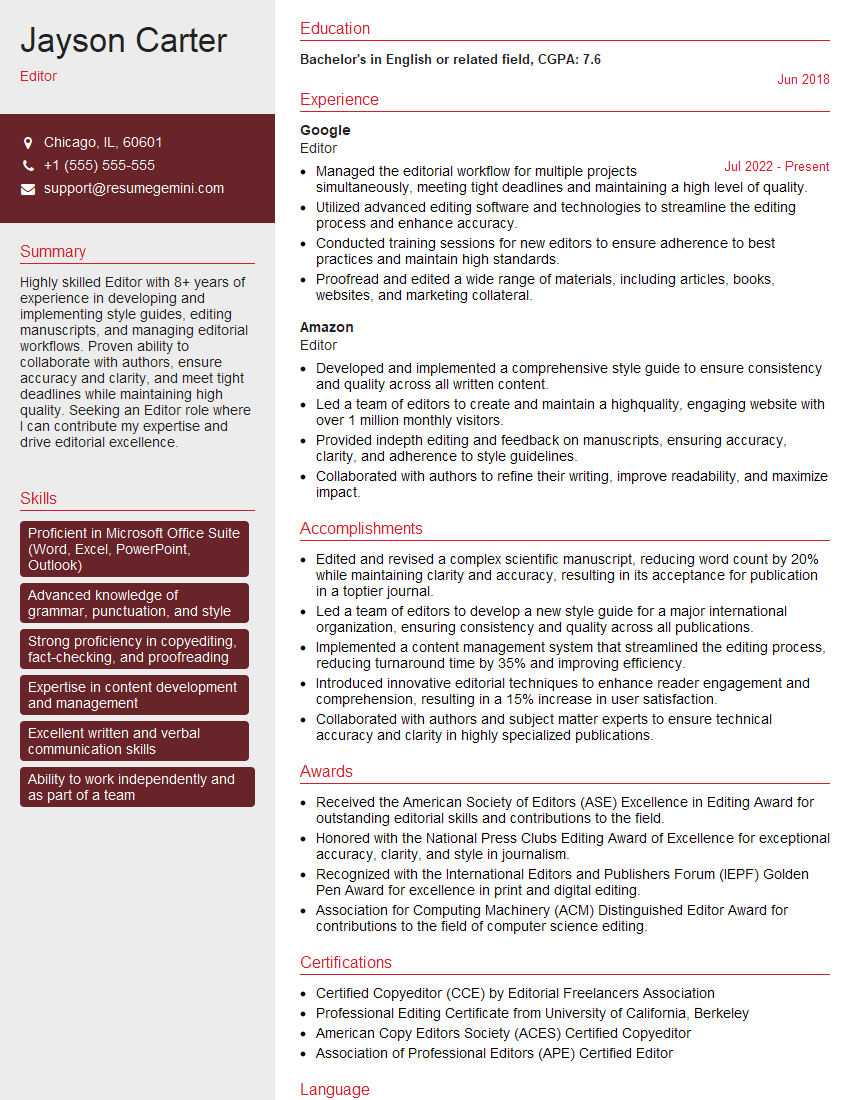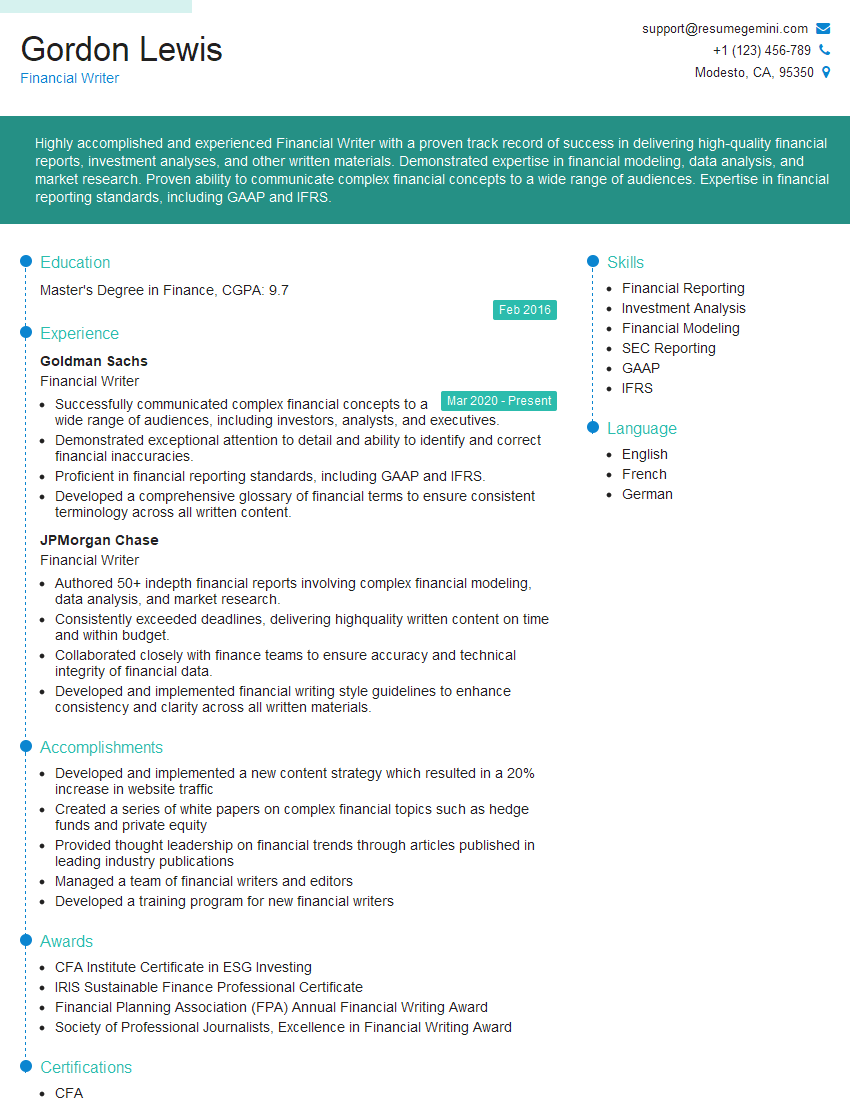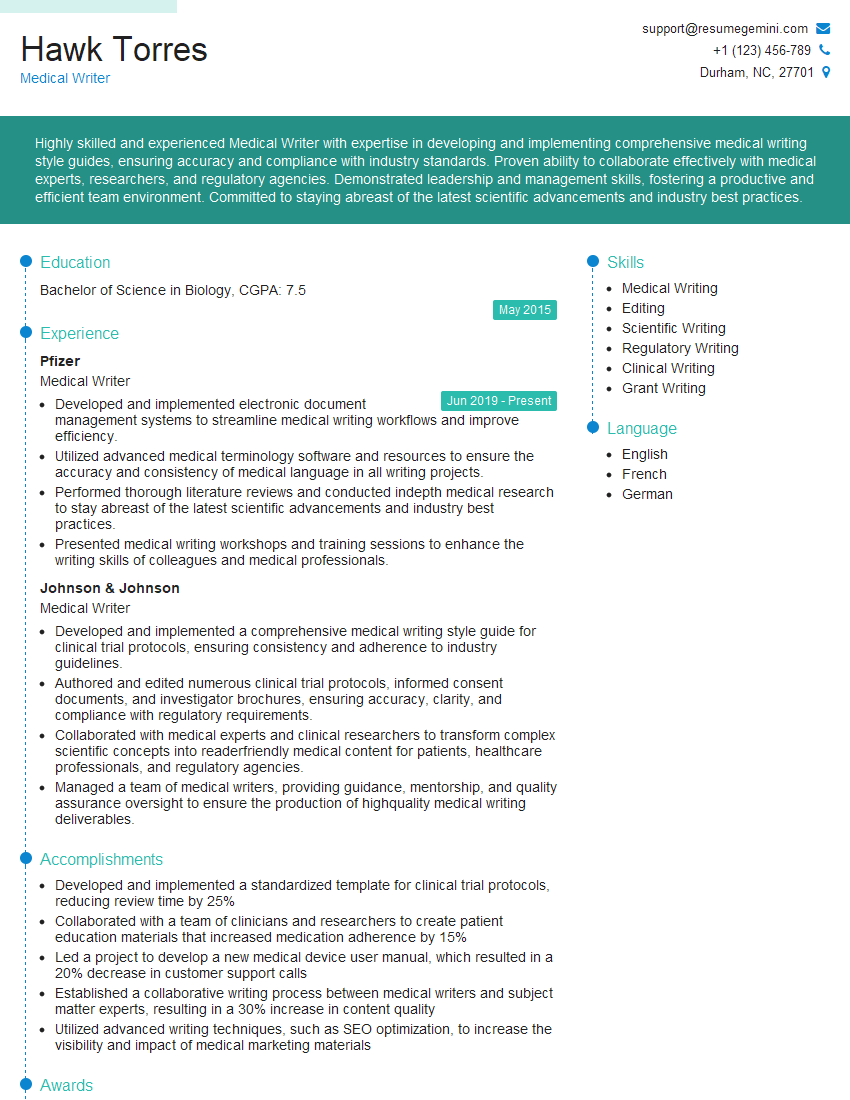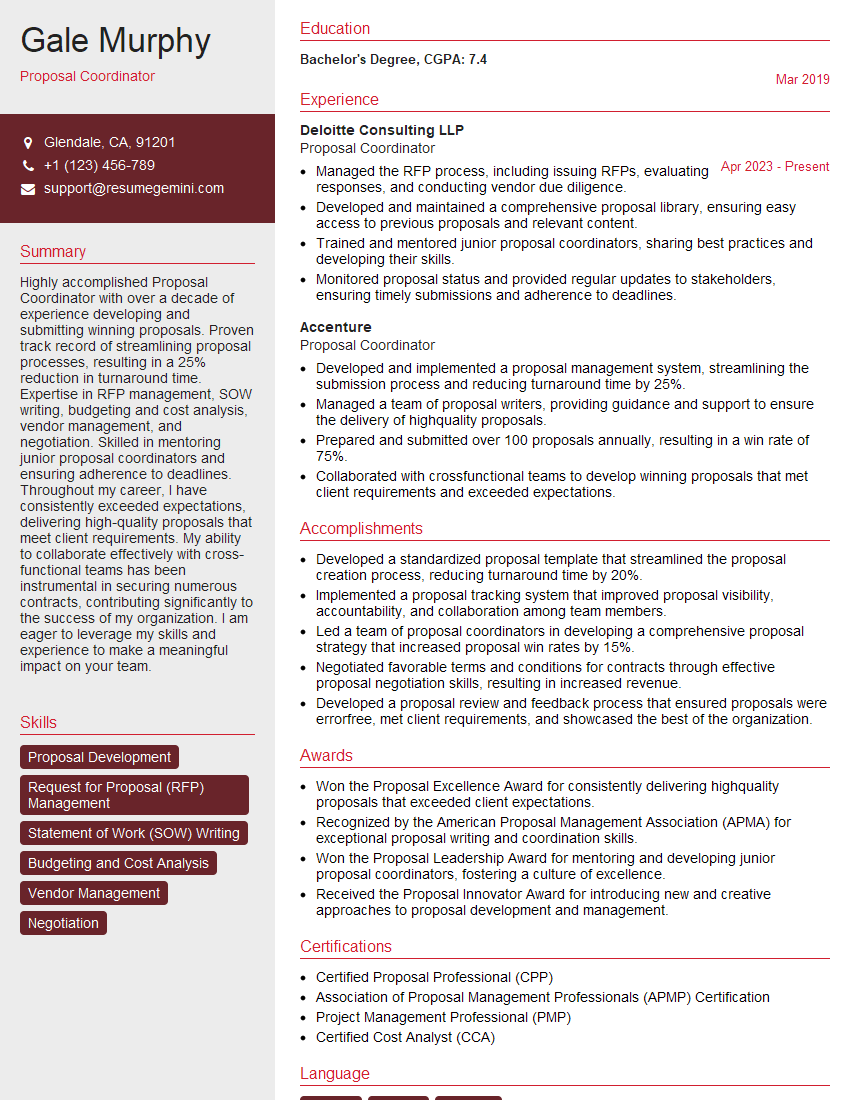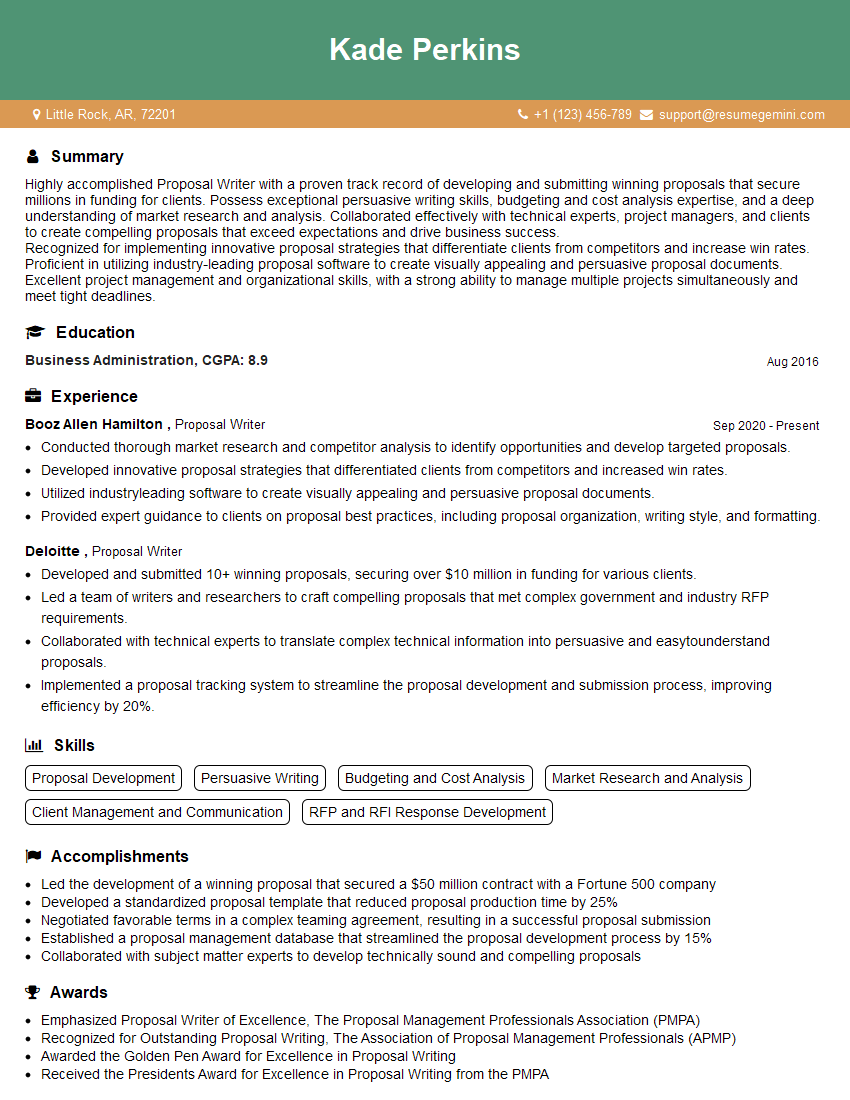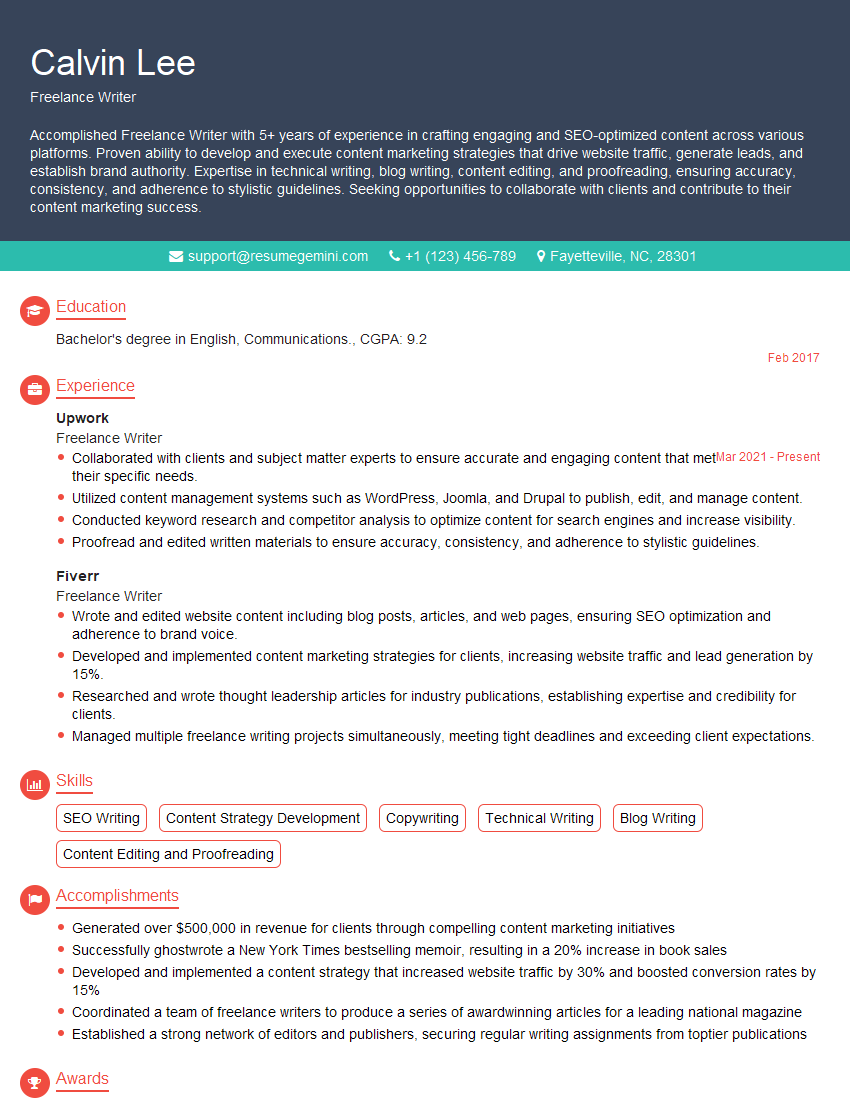Interviews are opportunities to demonstrate your expertise, and this guide is here to help you shine. Explore the essential Ability to write clear and concise proposals interview questions that employers frequently ask, paired with strategies for crafting responses that set you apart from the competition.
Questions Asked in Ability to write clear and concise proposals Interview
Q 1. Explain your process for structuring a compelling proposal.
Structuring a compelling proposal is like building a house: you need a solid foundation, a well-defined framework, and appealing aesthetics. My process begins with a thorough understanding of the client’s needs and objectives. I then create a clear and logical structure, typically following a standard format:
- Executive Summary: A concise overview of the entire proposal, highlighting key benefits and the proposed solution.
- Problem Statement: Clearly articulates the client’s challenge and its impact.
- Proposed Solution: Details the proposed solution, outlining its features, benefits, and how it addresses the identified problem. This often includes a phased approach, timelines and deliverables.
- Methodology: Explains the approach, processes, and strategies to be employed.
- Timeline & Milestones: Provides a clear project timeline with key milestones and deadlines.
- Team & Expertise: Showcases the skills and experience of the team involved.
- Budget & Pricing: Presents a detailed breakdown of costs and payment terms.
- Conclusion & Call to Action: Reiterates the key benefits and encourages the client to take the next step.
I always ensure a smooth flow between sections, creating a narrative that leads the reader to a clear understanding of the value proposition. Think of it as storytelling – engaging the reader and persuading them of the solution’s merit.
Q 2. How do you ensure your proposals are concise and avoid unnecessary jargon?
Conciseness and clarity are paramount. To avoid jargon, I always prioritize plain language. Before writing, I identify my target audience and tailor the language accordingly. I use simple, direct sentences and avoid technical terms unless absolutely necessary, and if used, I always define them. I actively employ the ‘kill your darlings’ approach, ruthlessly removing any unnecessary information or overly complex sentences. I frequently read my proposals aloud to identify areas that sound convoluted or unclear. This simple technique often reveals hidden jargon or wordiness.
For example, instead of writing ‘Leveraging synergistic methodologies to optimize operational efficacy,’ I would write ‘Using efficient methods to improve operations’. The difference is stark; the second version is easily understood by everyone, unlike the first.
Q 3. Describe a time you had to revise a proposal to meet specific client needs.
I once prepared a detailed proposal for a software implementation project for a large financial institution. The initial proposal focused heavily on technical specifications and advanced features. However, during the client presentation, it became clear that their priority was minimizing disruption to their existing systems and ensuring a quick return on investment. They needed a simplified solution, not a complex, feature-rich one.
I revised the proposal drastically. I removed sections detailing less critical features, emphasizing the ease of integration and the speedy implementation timeline. I re-organized the content to focus on the ROI and the minimal disruption aspects. We created new charts showing anticipated cost savings and streamlined the technical language significantly. The revised proposal successfully resonated with the client, leading to the project’s approval.
Q 4. What techniques do you use to identify the key message of a proposal?
Identifying the key message is crucial. I use several techniques: first, I define the central problem and proposed solution. What is the core value proposition? I then distill this down into a single, concise sentence that encapsulates the proposal’s essence. This becomes the ‘elevator pitch’ – the summary I could give if I only had a few seconds to explain it. I also use a mind map to visualize all the key points and then prioritize them based on importance to the client. Finally, I review the proposal through the lens of the client – What are their biggest concerns? What information is most critical to them?
For instance, if the proposal is for a marketing campaign, the key message might be: ‘Increase brand awareness by 20% within six months through a targeted social media campaign.’
Q 5. How do you tailor a proposal to different audiences?
Tailoring a proposal to different audiences requires understanding their unique perspectives and needs. A technical proposal for engineers would differ significantly from a marketing proposal for executives. I modify the tone, language, and content accordingly. For technical audiences, I use precise terminology and focus on the technical specifications. For less technical audiences, I simplify the language, focus on benefits, and use visuals to support my points. I always consider the audience’s level of expertise and their likely interests.
For example, when presenting to a technical team, I’d emphasize the technical architecture and innovation; while to a board of directors, I’d focus on the financial projections and the strategic alignment with their overall goals.
Q 6. How do you ensure your proposals are easy to read and understand?
Readability is vital. I use clear and concise language, avoid jargon, and employ visual aids like charts, graphs, and bullet points to break up large blocks of text. I maintain a consistent font and font size, using headings and subheadings to structure the content logically. White space is crucial; I use generous margins and spacing to make the proposal visually appealing and easy to scan. Finally, I always get a fresh pair of eyes to review for clarity and ensure the proposal is easily understood by the target audience.
Q 7. What tools or software do you use to create and manage proposals?
I utilize a variety of tools to create and manage proposals. For writing and formatting, I primarily use Microsoft Word and Google Docs for their collaborative capabilities. I often create presentations in PowerPoint or Google Slides to complement the written proposal. For project management and tracking, I rely on tools like Asana or Trello to manage deadlines and milestones. For creating professional-looking graphics, I may utilize Canva or Adobe Illustrator. Finally, proposal management software like PandaDoc or Proposify can streamline the process and aid in tracking progress and client feedback.
Q 8. How do you incorporate visuals and data effectively into a proposal?
Visuals and data are crucial for making a proposal compelling and persuasive. They shouldn’t just be decorative; they need to support and enhance your arguments. My approach involves strategically integrating them to clarify complex information, highlight key findings, and improve reader engagement.
Choosing the right visuals: I select visuals – charts, graphs, infographics, images – based on the type of data being presented and the audience. For example, a bar chart is great for comparing different categories, while a line graph shows trends over time. I avoid cluttered or overly complex visuals that could confuse the reader.
Data presentation: Data should be presented concisely and accurately. I ensure all data sources are clearly cited and that the visuals accurately reflect the underlying data. I also avoid manipulating data to present a biased perspective.
Integration with text: Visuals aren’t stand-alone elements. They need to be seamlessly integrated into the text. I use clear captions and labels, and I refer to the visuals within the text to guide the reader’s attention.
Example: In a proposal for a marketing campaign, I might use a bar chart showing the projected ROI for different strategies, and then discuss the implications of each strategy in the accompanying text. This allows a quick visual grasp alongside detailed written explanation.
Q 9. Describe your approach to proofreading and editing proposals.
My proofreading and editing process is meticulous and involves multiple stages. It’s not just about catching typos; it’s about ensuring the proposal is clear, concise, persuasive, and error-free.
First pass: I focus on the big picture – the flow, logic, and overall persuasiveness of the argument. Are the key messages clear? Is the structure logical? Does the proposal meet the client’s needs?
Second pass: I check for clarity and conciseness. I eliminate jargon, wordiness, and ambiguous phrasing. I ensure the tone is consistent and appropriate for the audience.
Third pass: This is a thorough proofread for grammar, spelling, punctuation, and formatting errors. I use a combination of automated tools and manual review.
Final review: A fresh pair of eyes is always helpful. I often have a colleague review the proposal before submission to catch any remaining errors or inconsistencies.
Q 10. How do you handle feedback from stakeholders on proposals?
Handling feedback is crucial for producing a successful proposal. My approach is collaborative and focused on understanding the feedback’s intent and integrating it effectively.
Active listening: I carefully review all feedback, actively listening to understand the concerns and suggestions.
Clarification: If any feedback is unclear, I seek clarification from the stakeholder. I want to make sure I understand what changes are needed.
Prioritization: I prioritize feedback based on its impact on the overall proposal. Critical feedback takes precedence over minor suggestions.
Implementation: I make the necessary revisions and provide a revised version for review. I also document all changes made and why.
Communication: I maintain open and transparent communication throughout the feedback process, keeping stakeholders informed of progress and addressing any concerns promptly.
Q 11. Explain your process for tracking progress on proposal development.
I use a project management approach to track proposal development. This ensures all tasks are completed on time and within budget.
Project plan: I create a detailed project plan that outlines all tasks, deadlines, and responsibilities. This plan is shared with all relevant stakeholders.
Task management tool: I use a task management tool (e.g., Asana, Trello, or even a simple spreadsheet) to track progress on each task. This allows for real-time monitoring and identification of potential delays.
Regular check-ins: I schedule regular check-ins with the team to discuss progress, address any challenges, and ensure everyone is on track.
Documentation: I maintain detailed documentation of all progress, decisions, and revisions. This helps to track the evolution of the proposal and ensures consistency.
Q 12. How do you balance the need for detail with conciseness in proposal writing?
Balancing detail and conciseness is a key skill in proposal writing. Too much detail can overwhelm the reader, while too little can leave questions unanswered. My strategy is to focus on providing enough detail to support the key arguments without getting bogged down in unnecessary information.
Know your audience: The level of detail required depends on the audience’s familiarity with the subject matter. Technical audiences might require more detail than non-technical audiences.
Prioritize information: Focus on the most important information and present it clearly and concisely. Less critical details can be included in appendices or supporting documents.
Use strong verbs and precise language: Avoid jargon and wordiness. Use active voice and strong verbs to communicate information efficiently.
Structure for clarity: Organize the proposal logically, using headings, subheadings, bullet points, and visuals to break up large blocks of text.
Q 13. Describe your experience writing proposals for different industries or sectors.
I have experience writing proposals for diverse sectors, including technology, healthcare, and non-profit organizations. Each sector has its unique requirements and communication styles. For example, a tech proposal requires a focus on technical specifications and innovative solutions, while a healthcare proposal needs to address compliance regulations and patient outcomes. I adapt my writing style and content to meet the specific needs of each sector.
Technology: I’ve written proposals for software development, cloud solutions, and cybersecurity projects, focusing on technical specifications, ROI, and competitive advantages.
Healthcare: My experience includes proposals for medical equipment, healthcare IT systems, and clinical research studies, emphasizing compliance with regulatory standards, patient benefits, and cost-effectiveness.
Non-profit: I’ve developed proposals for grant applications, fundraising campaigns, and community development projects, highlighting the social impact, sustainability, and community engagement.
Q 14. How do you handle objections or challenges to your proposals?
Handling objections and challenges is an integral part of proposal writing. My approach is proactive and focuses on addressing concerns directly and persuasively.
Anticipate objections: Before submitting the proposal, I try to anticipate potential objections and address them preemptively within the proposal itself.
Directly address objections: When objections arise, I address them directly and honestly. I provide evidence and data to support my claims and refute any misconceptions.
Propose solutions: I don’t simply dismiss objections; I offer solutions and alternatives. I demonstrate my flexibility and willingness to work collaboratively.
Maintain professionalism: Throughout the process, I maintain a professional and respectful demeanor, even when facing difficult challenges. I focus on finding common ground and achieving a mutually beneficial outcome.
Q 15. How do you prioritize information when crafting a proposal?
Prioritizing information in a proposal is crucial for clarity and impact. Think of it like building a house – you wouldn’t start with the roof! I use a tiered approach:
- Essential Information: This forms the core of your argument. It directly addresses the client’s needs and the problem you’re solving. This includes your proposed solution, key benefits, and a strong value proposition.
- Supporting Information: This provides evidence and context for the essential information. Think case studies, data, testimonials, and qualifications. This strengthens your credibility and persuasiveness.
- Supplementary Information: This is extra information that adds value but isn’t crucial to your core message. Think detailed timelines, optional add-ons, or in-depth technical specifications. This should be readily available but not overwhelming.
For example, in a proposal for a marketing campaign, the essential information would be the proposed strategy, target audience, and projected ROI. Supporting information might include case studies of similar successful campaigns. Supplementary information could be detailed reports on market analysis.
Career Expert Tips:
- Ace those interviews! Prepare effectively by reviewing the Top 50 Most Common Interview Questions on ResumeGemini.
- Navigate your job search with confidence! Explore a wide range of Career Tips on ResumeGemini. Learn about common challenges and recommendations to overcome them.
- Craft the perfect resume! Master the Art of Resume Writing with ResumeGemini’s guide. Showcase your unique qualifications and achievements effectively.
- Don’t miss out on holiday savings! Build your dream resume with ResumeGemini’s ATS optimized templates.
Q 16. What metrics do you use to measure the success of a proposal?
Measuring proposal success goes beyond simply winning the contract. I use a multi-faceted approach:
- Win Rate: The percentage of proposals submitted that result in a contract. This is a straightforward measure of overall effectiveness.
- Client Satisfaction: Post-project feedback from clients helps assess whether the proposal accurately reflected the final deliverables and met their expectations.
- Proposal Feedback Analysis: Even unsuccessful proposals can provide valuable insights. Analyzing feedback from clients (even if they choose a competitor) helps identify areas for improvement in future proposals.
- Time to Contract: A shorter time from proposal submission to contract signing indicates a clear, persuasive, and efficient proposal.
- Return on Investment (ROI): For internal projects, measuring the ROI against the resources invested in creating the proposal is vital for justifying the effort.
For example, a high win rate but low client satisfaction suggests a problem with accurately reflecting the deliverables in the proposal. Conversely, a low win rate but positive feedback on proposal clarity indicates other factors, such as competitor pricing, are at play.
Q 17. How do you stay up to date on proposal writing best practices?
Staying updated on best practices is continuous learning. I utilize several methods:
- Professional Organizations: Membership in organizations like the Association of Proposal Management Professionals (APMP) provides access to resources, training, and networking opportunities.
- Industry Publications and Blogs: Regularly reading journals, articles, and blogs focused on proposal writing keeps me informed about current trends and best practices.
- Conferences and Workshops: Attending industry events allows for direct learning from experts and peers, as well as the chance to network.
- Online Courses: Platforms like Coursera and LinkedIn Learning offer courses on proposal writing and related skills.
- Mentorship: Seeking guidance from experienced proposal writers allows for personalized feedback and knowledge sharing.
I also analyze successful proposals from different industries and adapt the best elements to my own work. This is a crucial part of refining my technique and improving the quality of my proposals.
Q 18. Describe a time you had to overcome a writing challenge in a proposal.
In a recent proposal for a complex software implementation, we faced a challenge communicating highly technical information to a non-technical client. Our initial draft was too jargon-heavy and lacked clear, relatable examples.
To overcome this, we:
- Simplified the language: We replaced technical terms with plain English equivalents and avoided unnecessary jargon.
- Used visual aids: We incorporated diagrams, flowcharts, and screenshots to illustrate complex processes.
- Added relatable analogies: We compared the software to familiar everyday concepts to make the explanation more accessible.
- Focused on benefits, not features: Instead of listing technical features, we emphasized the benefits for the client, highlighting how the software would solve their problems and improve their business.
The revised proposal was much more effective, resulting in a successful bid. This experience highlighted the importance of tailoring the proposal to the client’s level of understanding.
Q 19. How do you collaborate effectively with others to create proposals?
Collaboration is key to creating effective proposals. My approach emphasizes clear communication and defined roles:
- Project Kick-off Meeting: I initiate a meeting with all stakeholders to define the scope, objectives, target audience, and deadlines.
- Role Assignment: We clearly define individual responsibilities, ensuring each person understands their contribution (e.g., content writing, design, editing).
- Centralized Document Management: We use collaborative tools (e.g., Google Docs, SharePoint) for easy access and revision tracking.
- Regular Check-ins: We schedule regular meetings for updates, feedback, and problem-solving.
- Constructive Feedback: We encourage open and honest feedback throughout the process, ensuring everyone feels comfortable contributing.
This collaborative approach fosters a sense of ownership and ensures the final proposal reflects the collective knowledge and expertise of the team.
Q 20. Explain your understanding of the different types of proposals (e.g., RFP, RFI).
Different proposal types serve distinct purposes:
- Request for Proposal (RFP): A formal invitation from a client seeking detailed proposals from multiple vendors. RFPs usually specify requirements, evaluation criteria, and submission deadlines. They require a highly structured and comprehensive response.
- Request for Information (RFI): A less formal request seeking information about a vendor’s capabilities and offerings. RFIs are often used for preliminary market research or to gauge vendor interest before issuing an RFP.
- Request for Quotation (RFQ): A request for pricing information from multiple vendors for a specific product or service. RFQs are typically used when the specifications are clearly defined and the focus is primarily on cost.
- Unsolicited Proposal: A proposal submitted proactively to a client without a formal invitation. These require strong understanding of the client’s needs and a compelling value proposition.
Understanding the specific requirements of each type is essential for crafting a successful and winning proposal.
Q 21. What’s your process for ensuring the proposal aligns with the client’s budget?
Budget alignment is paramount. My process involves:
- Early Budget Discussion: I initiate conversations with the client early in the process to understand their budget constraints and priorities.
- Value Engineering: I identify opportunities to maximize value while remaining within budget. This may involve adjusting the scope of work or proposing alternative solutions.
- Phased Approach: For larger projects, proposing a phased approach allows for budget control and easier management of deliverables.
- Transparency and Clarity: The proposal clearly outlines all costs, including labor, materials, and any potential additional expenses. Any assumptions or estimations are clearly stated.
- Negotiation and Flexibility: I’m prepared to negotiate and adjust the proposal to meet the client’s budget while still delivering exceptional value.
This proactive approach prevents surprises and ensures a mutually beneficial agreement.
Q 22. How do you deal with ambiguous client requirements in a proposal?
Ambiguous client requirements are a common challenge in proposal writing. My approach involves a multi-step process to clarify expectations and ensure a successful proposal. First, I actively engage in a detailed discussion with the client, asking clarifying questions to pinpoint their needs, goals, and desired outcomes. This often involves probing beyond the surface level to uncover unspoken assumptions or underlying needs. I use open-ended questions like, “Can you elaborate on what you mean by ‘improved efficiency’?” or “What are the key metrics you’ll use to measure the success of this project?” Second, I summarize my understanding in writing, sharing a draft of the requirements back to the client for confirmation. This avoids misunderstandings and ensures everyone is on the same page. Finally, I build flexibility into the proposal itself, acknowledging potential areas of uncertainty and outlining contingency plans. For example, I might include a phased approach with milestones or offer different pricing models depending on the final scope of work. This proactive approach transforms ambiguity into an opportunity for collaboration and creates a stronger foundation for a successful project.
Q 23. Describe your experience presenting proposals to clients.
I have extensive experience presenting proposals to clients across various industries. My presentations are always tailored to the specific audience and proposal content. I start by building rapport, establishing a personal connection with the decision-makers before diving into the specifics. I use visuals effectively, employing charts, graphs, and images to illustrate key points and data, making the information easier to digest. I focus on clear and concise communication, avoiding jargon and technical terms whenever possible. Instead of simply reading the proposal aloud, I present it as a story, highlighting the value proposition and demonstrating how our solution directly addresses the client’s challenges. Throughout the presentation, I encourage interaction, answering questions and addressing concerns openly and honestly. Post-presentation, I follow up with a written summary of key takeaways and next steps to ensure clear action planning. For instance, in a recent proposal for a software solution, I used a live demo to showcase the product’s functionalities, engaging the clients directly and leaving a lasting impression.
Q 24. How do you create a compelling call to action in a proposal?
A compelling call to action (CTA) is crucial for driving the next steps in the sales process. It should be clear, concise, and directly related to the proposal’s key message. Instead of a generic “Let’s get started,” I craft a CTA that is specific, time-bound, and reflects a sense of urgency. For example, ‘Secure your project’s success by signing this contract within the next 7 days and receive a 10% discount.’ This approach provides a concrete next step, highlighting the benefits of immediate action. I also use multiple CTAs throughout the proposal, reinforcing the overall message and creating opportunities for the client to engage at various points. Additionally, I tailor the CTA to the specific client, considering their decision-making style and timeline. A CTA should never feel forced or manipulative; instead, it should naturally flow from the proposal’s content, offering a clear path forward.
Q 25. How do you adapt your writing style to different proposal types?
Adapting my writing style to different proposal types is essential for effective communication. For example, a proposal for a government contract requires a formal and highly structured approach, adhering to specific guidelines and regulations. This contrasts with a proposal for a small business, which may require a more informal and conversational tone to build rapport. I adjust my language, formality, and overall structure based on the target audience and the context of the proposal. A technical proposal necessitates detailed explanations and the use of technical terminology, while a marketing proposal might emphasize creative visuals and storytelling. I meticulously research the client and the project to understand their preferences and tailor my style accordingly. Consistency in tone and style remains paramount regardless of the proposal type, ensuring professionalism and clarity throughout. This adaptability ensures my proposals resonate with the intended audience and effectively communicate the proposed solutions.
Q 26. How do you manage deadlines effectively when writing proposals?
Managing proposal deadlines effectively requires meticulous planning and a structured approach. I begin by creating a detailed project plan that outlines all the tasks involved, assigning realistic timelines to each. This involves breaking down the writing process into smaller, manageable steps, allowing for better tracking of progress. I utilize project management tools to monitor my progress, ensuring I stay on schedule. I prioritize tasks based on urgency and importance, focusing on critical elements first. Proactive communication with the client is essential; I keep them informed of progress updates and address any concerns promptly. Furthermore, I build in buffer time to account for unexpected delays or revisions. Flexibility is key – I am prepared to adjust the schedule if necessary, ensuring timely completion without compromising quality. My experience enables me to anticipate potential roadblocks and make adjustments proactively, leading to consistent on-time delivery.
Q 27. What are some common mistakes to avoid when writing proposals?
Several common mistakes can significantly hinder a proposal’s effectiveness. One frequent error is failing to thoroughly understand the client’s needs. A proposal addressing the wrong problem is doomed to fail. Another common pitfall is using generic templates without tailoring them to the specific client and project. This results in impersonal proposals that lack impact. Poor grammar, spelling errors, and inconsistent formatting create a unprofessional image. Focusing too much on features instead of benefits is another mistake; clients are more interested in how a solution will solve their problems, not just what it can do. Finally, omitting a clear and compelling call to action leaves the client without a clear next step. Avoiding these mistakes through careful planning, thorough research, and rigorous review ensures the proposal stands out and effectively communicates its value proposition. Proofreading is crucial – often, a fresh pair of eyes can catch overlooked errors.
Q 28. How do you ensure your proposals are compliant with legal requirements?
Ensuring compliance with legal requirements is paramount in proposal writing. This varies depending on the industry, client, and geographic location. I familiarize myself with all applicable laws and regulations relevant to the proposal, including data protection laws, contract law, and industry-specific compliance standards. I incorporate clauses and disclaimers as required, addressing issues such as intellectual property rights, confidentiality, and liability. For instance, when preparing a proposal for a government entity, I make sure to follow all procurement regulations and guidelines meticulously. If dealing with sensitive data, I incorporate appropriate security measures and data protection clauses. If necessary, I consult legal counsel to ensure complete compliance. Proactive compliance demonstrates professionalism and builds trust with the client, significantly enhancing the credibility of the proposal. A failure to meet legal requirements can lead to significant legal ramifications.
Key Topics to Learn for Ability to Write Clear and Concise Proposals Interview
- Understanding Your Audience: Identifying the key stakeholders and tailoring your proposal to their specific needs and priorities. Practical Application: Analyzing potential client profiles to determine the most effective communication style and key selling points.
- Structuring a Compelling Narrative: Developing a logical flow that clearly presents the problem, proposed solution, and expected outcomes. Practical Application: Creating a detailed outline before writing, ensuring a cohesive and persuasive argument.
- Concise and Impactful Writing: Using clear, active voice, avoiding jargon, and focusing on key benefits. Practical Application: Practicing summarizing complex information into easily digestible points.
- Data Visualization and Supporting Evidence: Effectively presenting data through charts, graphs, and other visuals to support your claims. Practical Application: Choosing the most appropriate visual representation for different data sets to maximize impact.
- Budgeting and Resource Allocation: Clearly outlining the costs and resources required to implement your proposal. Practical Application: Developing realistic budgets and justifying resource needs based on project scope.
- Responding to Objections and Potential Challenges: Anticipating potential concerns and addressing them proactively within the proposal. Practical Application: Developing a robust Q&A section to preempt potential questions.
- Proofreading and Editing: Ensuring the proposal is free of grammatical errors and typos. Practical Application: Utilizing proofreading tools and multiple review cycles before submission.
Next Steps
Mastering the ability to write clear and concise proposals is crucial for career advancement in many fields. A well-crafted proposal demonstrates strong communication, problem-solving, and strategic thinking skills – highly sought-after qualities in today’s competitive job market. Building an ATS-friendly resume is equally important to ensure your application gets noticed. ResumeGemini can be a trusted resource in this process, helping you create a professional and impactful resume that highlights your skills in proposal writing. Examples of resumes tailored to showcasing this ability are available to help guide you.
Explore more articles
Users Rating of Our Blogs
Share Your Experience
We value your feedback! Please rate our content and share your thoughts (optional).
What Readers Say About Our Blog
These apartments are so amazing, posting them online would break the algorithm.
https://bit.ly/Lovely2BedsApartmentHudsonYards
Reach out at [email protected] and let’s get started!
Take a look at this stunning 2-bedroom apartment perfectly situated NYC’s coveted Hudson Yards!
https://bit.ly/Lovely2BedsApartmentHudsonYards
Live Rent Free!
https://bit.ly/LiveRentFREE
Interesting Article, I liked the depth of knowledge you’ve shared.
Helpful, thanks for sharing.
Hi, I represent a social media marketing agency and liked your blog
Hi, I represent an SEO company that specialises in getting you AI citations and higher rankings on Google. I’d like to offer you a 100% free SEO audit for your website. Would you be interested?



